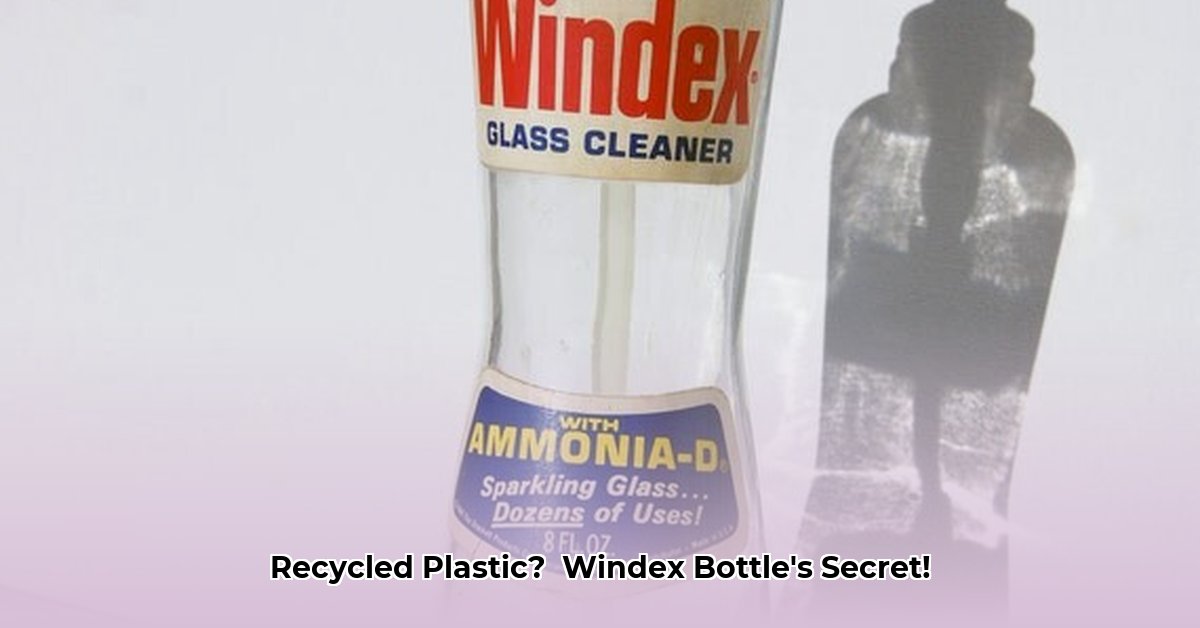Ever wonder if that Windex bottle promising “ocean plastic” really lives up to the hype? We dug deep to find out. This isn’t just a quick review; it’s a full investigation into Windex’s sustainability claims. We’ll examine the percentage of recycled plastic used, compare Windex to other brands, and assess if marketing aligns with reality. We’ll consult experts, share eco-cleaning tips, and detail the use of recycled materials. The goal? To help you decide if Windex is truly as green as it claims, and what that means for you and the planet.
Windex Bottle: The Truth Behind the Eco-Friendly Claims
Let’s examine the Windex bottle, the one claiming recycled ocean plastic. It sounds good, but a deeper dive reveals a more complex story. SC Johnson, Windex’s parent company, claims a strong commitment to sustainability, especially regarding recycled plastic. Are these claims as clean as the product promises?
SC Johnson emphasizes using 100% recycled coastal plastic. This aligns well with consumers wanting eco-conscious products. However, a detail emerges: sometimes “ocean-bound plastic,” sometimes “recovered coastal plastic” is mentioned. The subtle differences impact environmental meaning. This ambiguity raises concerns about transparency.
Windex highlights cleaning performance, citing Nielsen data for “unbeatable streak-free shine.” But how recent is that data? Is it still relevant? More importantly, what about the rest of the product? The bottle is one aspect of sustainability. We must consider ingredients and manufacturing. Focusing solely on packaging distracts from the overall picture. Truly understanding Windex’s eco-friendliness requires a complete assessment, like a full lifecycle assessment (LCA) – assessing the entire product chain’s environmental impacts.
SC Johnson partners with Plastic Bank, aiming to reduce ocean plastic pollution. This partnership aligns with using recycled materials. How effective is it? How much plastic is diverted from oceans? Is the supply chain reliable enough for Windex’s production? Answering these questions is vital for understanding the initiative’s true impact.
Beyond the bottle, we need to consider the entire product life cycle. Manufacturing, transport, and ingredients all contribute to the environmental footprint. A complete Life Cycle Assessment (LCA) would provide a clearer picture. An LCA would consider the product’s carbon footprint and the long-term effects of cleaning chemicals. Understanding potential less harmful alternatives is also crucial.
The current situation highlights the need for transparency. Consumers should trust company sustainability claims. Ambiguous communication about recycled plastic undermines this trust. Buying decisions are increasingly based on environmental impact, so unclear messaging is unacceptable. Real change requires complete, verifiable data on products’ environmental impact.
Recommendations:
| Stakeholder | Short-Term Actions | Long-Term Actions |
|---|---|---|
| SC Johnson (Windex) | Clearly define the type of recycled plastic used; make this information readily available on their website. | Conduct a thorough, transparent LCA; analyze potential biodegradable or less environmentally impactful ingredients. |
| Consumers | Look for products with transparent and easy-to-understand sustainability information. | Actively demand complete information about the impact of products throughout their entire life cycle. |
| Retailers | Actively promote products that have clear and credible sustainability claims. | Support and make visible eco-friendly alternatives in stores. |
| Plastic Bank | Improve communication about collaborations with companies. | Expand operations and ensure stable, transparent supply chains. |
Using recycled plastic in Windex bottles is a step toward sustainability, but only part of the process. Further investigation and transparent information are vital for understanding the overall effect on the environment. The future of sustainable cleaning depends on honest communication and clear actions. What are your thoughts on Windex’s sustainability efforts?
How Does Windex’s Recycled Plastic Sourcing Impact Its Overall Environmental Footprint?
Are manufacturers doing enough, or are there more sustainable solutions?
Key Takeaways:
- Windex’s use of 100% recovered coastal plastic in select bottles significantly reduces reliance on virgin plastic, diverting millions of bottles from landfills and oceans.
- The initiative creates economic opportunities in coastal communities through partnerships with Plastic Bank.
- However, the success of this approach depends on several factors, including broader consumer acceptance of sustainable packaging and the ongoing challenge of low global recycling rates.
Ocean-Bound Plastic: A Step, But Part of a Bigger Picture
Windex’s commitment to using 100% ocean-bound plastic in some bottles is a significant step, a large drop in a vast expanse of plastic waste. They’ve recovered a substantial amount of coastal plastic, equivalent to millions of bottles, helping to divert plastic from polluting our oceans and landfills.
The partnership with Plastic Bank offers economic opportunities to communities struggling with plastic waste, turning a problem into a source of income. How does Windex’s recycled plastic sourcing impact its overall environmental footprint beyond these benefits?
The Bigger Picture: Recycling Rates and Consumer Habits
Global plastic recycling rates remain low, around 9%. Recycling isn’t a universal solution. Even with Windex’s progress, the problem of plastic waste is far from solved. What about the production and transportation of these materials? What about the end-of-life management of the bottles themselves?
Consumer habits are critical. Will consumers embrace refillable bottles and concentrated products, even if it means inconvenience or cost increase? How does Windex’s recycled plastic sourcing impact its overall environmental footprint if consumers prefer single-use packaging?
The Economic Reality of Sustainable Packaging
Switching to sustainable packaging involves significant upfront investments. These costs can impact profitability and market competitiveness, creating a challenge for businesses. How does Windex’s recycled plastic sourcing impact its overall environmental footprint in light of these realities?
Will consumers pay extra for sustainable options? Market demand plays a significant role in whether companies can justify the expense.
The Role of Government and Future Outlook
Government regulations and incentives can dramatically influence the outcome. Policymakers have a vital role to play in establishing a supportive environment for sustainable practices through incentives, regulations, and investments in recycling infrastructure. Therefore, how does Windex’s recycled plastic sourcing impact its overall environmental footprint depends on the collective action of businesses, consumers, and governments.
Windex Refill Bottles: Sustainable Cleaning Solutions for Eco-Conscious Homes
Consumers are increasingly prioritizing eco-friendly cleaning products.
Key Takeaways:
- Windex’s refill program uses Ocean Bound Plastic (OBP), a step towards sustainability.
- However, the program’s overall environmental impact needs further scrutiny.
- Concrete data on plastic waste reduction is lacking.
A Sparkling Clean Conscience? Examining Windex’s Refill Commitment
SC Johnson’s Windex Refill Bottles: Sustainable Cleaning Solutions for Eco-Conscious Homes initiative promises a greener clean. How green is it, really? Their use
- Why an App Appeared on My Phone Unexpectedly - November 22, 2025
- How to Stop Unwanted Apps from Automatically Downloading on Android - November 21, 2025
- Why Are Android Games Installing Themselves on Your Phone? - November 20, 2025










